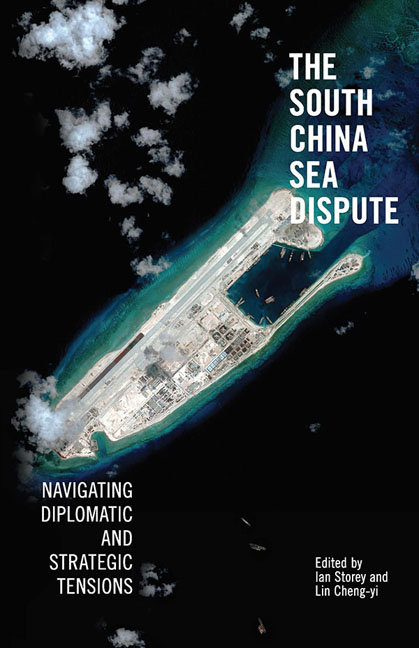Book contents
- Frontmatter
- Contents
- About the Contributors
- 1 Introduction
- 2 Untangling a Complex Web: Understanding Competing Maritime Claims in the South China Sea
- 3 China Debates the South China Sea Dispute
- 4 Taiwan's Evolving Policy towards the South China Sea Dispute, 1992–2016
- 5 The South China Sea: Primary Contradictions in China–Southeast Asia Relations
- 6 Rising Tensions in the South China Sea: Southeast Asian Responses
- 7 The Philippines and the South China Sea Dispute: Security Interests and Perspectives
- 8 A Vietnamese Perspective on the South China Sea Dispute
- 9 The South China Sea Dispute: Options for Malaysia
- 10 The United States and the South China Sea: Front Line of 228 Hegemonic Tension?
- 11 The South China Sea Dispute in U.S.–ASEAN Relations
- 12 Japan and the South China Sea Dispute: A Stakeholder's Perspective
- 13 Conclusion
- Index
8 - A Vietnamese Perspective on the South China Sea Dispute
Published online by Cambridge University Press: 19 May 2017
- Frontmatter
- Contents
- About the Contributors
- 1 Introduction
- 2 Untangling a Complex Web: Understanding Competing Maritime Claims in the South China Sea
- 3 China Debates the South China Sea Dispute
- 4 Taiwan's Evolving Policy towards the South China Sea Dispute, 1992–2016
- 5 The South China Sea: Primary Contradictions in China–Southeast Asia Relations
- 6 Rising Tensions in the South China Sea: Southeast Asian Responses
- 7 The Philippines and the South China Sea Dispute: Security Interests and Perspectives
- 8 A Vietnamese Perspective on the South China Sea Dispute
- 9 The South China Sea Dispute: Options for Malaysia
- 10 The United States and the South China Sea: Front Line of 228 Hegemonic Tension?
- 11 The South China Sea Dispute in U.S.–ASEAN Relations
- 12 Japan and the South China Sea Dispute: A Stakeholder's Perspective
- 13 Conclusion
- Index
Summary
The South China Sea has tremendous geostrategic and geoeconomic importance, and the dispute over conflicting territorial and boundary claims resonates across the Asia-Pacific region and beyond. At the root of current tensions is China's expansive maritime claims as indicated by its nine-dash line map, which covers over 80 per cent of the 3.5 million square kilometres of the South China Sea, and which overlaps with the 200 nautical miles (nm) exclusive economic zones (EEZ) of the four Southeast Asian claimants: Brunei, Malaysia, the Philippines and Vietnam. China's growing assertiveness in the South China Sea has contributed to rising tensions since 2007–8. As some of the claimants have been rapidly modernizing their military forces, and nationalist sentiment is rising, the risk of armed conflict is growing. In the event that conflict does break out, it could be wider in scope and longer in duration than previous clashes. The repercussions, moreover, would be global.
Developments over the past several years have given rise to a number of important questions. Has China deviated from Deng Xiaoping's principle of “hiding capabilities and biding time” (Tao guang, yang hui) in order to pursue a more assertive foreign policy which challenges the existing regional and international order? What has motivated China's recent assertiveness? Is there a linkage between China's more strong-willed posture and America's “pivot” or “rebalancing” in the Asia Pacific, or between the Philippine and Vietnamese “assertiveness” as claimed by China? How should the international community respond to the situation in the South China Sea? Most importantly, how can the risk of conflict in the area be reduced? This chapter attempts to answer these questions from the Vietnamese perspective.
CHINA'S GROWING ASSERTIVENESS IN THE SOUTH CHINA SEA
Since the establishment of the People's Republic of China (PRC) in 1949, Beijing has consistently pursued the goal of asserting its sovereignty claims in the South China Sea in an effort to dominate the entire maritime region. However, during the period from 1949 to 1979, China was restricted from enforcing its extensive claims due to the limited capabilities of the People's Liberation Army Navy (PLA-Navy). This did not, however, prevent China from seizing opportunities to expand its presence in the South China Sea when they arose, such as the seizure of the western Paracels from the Republic of Vietnam (South Vietnam) in 1974, which took place as U.S. forces were about to withdraw from that country.
- Type
- Chapter
- Information
- The South China Sea DisputeNavigating Diplomatic and Strategic Tensions, pp. 186 - 204Publisher: ISEAS–Yusof Ishak InstitutePrint publication year: 2016

